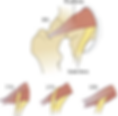TRIGGER POINT OF THE WEEK – PIRIFORMIS
- Simeon Asher
- Sep 15, 2019
- 2 min read

Much has been written about this small deep pear-shaped external rotator of the hip. Trigger points in the Piriformis muscle have an intimate relationship with sciatic and pseudo-sciatic pain. The Piriformis takes its origin from the internal surface of the sacrum and from the Sacrotuberous ligament. It inserts into the superior border of the greater trochanter of the hip. Trigger point pain in the Piriformis often presents as a constant “deep” ache in buttock, sciatica (pseudosciatica), vascular compression posterior legs, low back/buttock pain (worse when sitting). Classically this ache often starts after a fall or sitting on wallet when driving. Pain is aggravated by sitting and is up to six times more common in women.

MUSCLE COMMENT
Piriformis syndrome
The sciatic nerve is a thick and long nerve in the body. It passes alongside or goes through the Piriformis muscle, goes down the back of the leg, and eventually branches off into smaller nerves that end in the feet. There are several natural variations in sciatic nerve morphology which may predispose patients to Piriformis syndrome. It has been suggested nerve compression can be caused by spasm of the Piriformis muscle (myopathic neuropathy).

Piriformis Syndrome Signs and Symptoms
Piriformis syndrome usually starts with pain, tingling, or numbness in the buttocks. Pain can be severe and extend down the length of the sciatic nerve (called sciatica). The pain is due to the piriformis muscle compressing the sciatic nerve, such as while sitting on a car seat or running. Pain may also be triggered while climbing stairs, applying firm pressure directly on the trigger points in the piriformis muscle.Deactivating trigger points in piriformis can have a considerably beneficial effect on some presentations of sciatica.
How do you treat trigger these trigger points? We’d be delighted if you want to share your own best practice.
